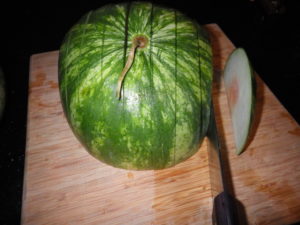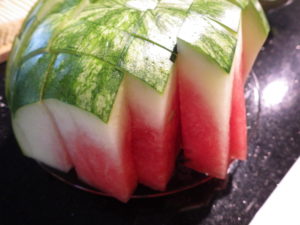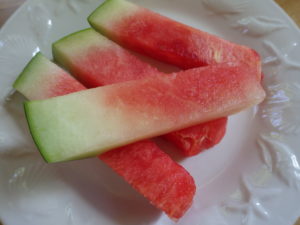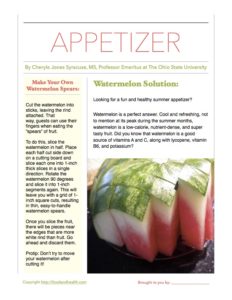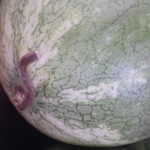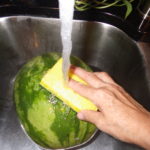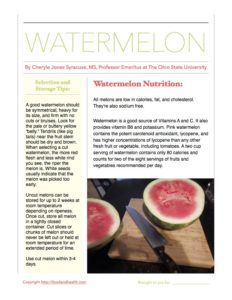Try this fun quiz from Cheryle Jones Syracuse to celebrate watermelons while promoting good health…
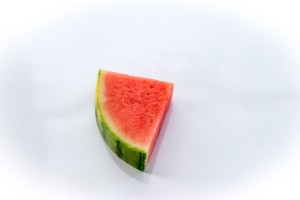 I often wonder when I see people at the grocery store thumping on watermelons. Do they really know what they are listening for?
I often wonder when I see people at the grocery store thumping on watermelons. Do they really know what they are listening for?
There’s an old saying about thumping a watermelon:
A good watermelon should sound hollow… like if you thumped your chest.
If it sounds like you’re hitting your head… it’s not ripe.
If it sounds like thumping on your stomach… it’s definitely too ripe.
Now I’ve given this saying some thought, and I’m not sure that I could judge any of those sounds. There has to be a better way to evaluate these fruits. I did some research, consulted with some colleagues, and have returned with a fun quiz that offers insight into how to select, store, and prepare watermelon. Of course, I’ve also included information about a watermelon’s nutrient content and health benefits. What better way to celebrate National Watermelon Day?
The quiz is available in the text of this blog, and an abridged version is also available as a downloadable handout! So check out the options below and, if you like what you see, get the handout for free!
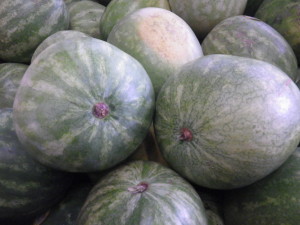
See the yellow “belly” on that watermelon?
Watermelon Quiz:
How much do you know about watermelon? Take this quiz and find out!
- True or False? Uncut whole watermelon should be refrigerated.
- True or False? Since you’re not eating the rind, you don’t need to wash the outside of a watermelon before cutting into it.
- True or False? The red pigment in watermelon is a good source of the phytochemical lycopene.
- True or False? The “belly” of a ripe watermelon should be yellow.
- True or False? Like the name implies, watermelon is made of mostly water.
- True or False? Watermelon does not really have any nutritional value.
- True or False? Watermelon is a good source of potassium and sodium.
- True or False? The rind of a watermelon should not be eaten.
- True or False? It’s okay to swallow watermelon seeds.
- True or False? The “hollow” heart sometimes found inside a watermelon is caused by someone dropping the melon.
- True or False? Watermelon is a cousin to cucumbers and squash.
- True or False? A good way to tell if a watermelon is ripe is by giving it a good thump.
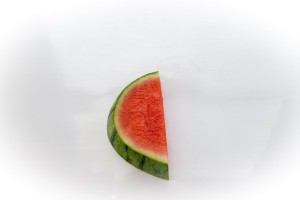 Answer Key:
Answer Key:
- FALSE: Uncut whole watermelon can be kept in a cool, dry place and does not need to be refrigerated. Stored this way, a watermelon will keep for 7-10 days at room temperature. Once cut, leftover watermelon should be covered and refrigerated. Be cautious of purchasing cut melons at farmer’s markets if they have not been kept cool after cutting. Use cut watermelon within 5 days.
- FALSE: The outside rind of the watermelon should be washed before you cut into it. Bacteria found on the outside may easily be transferred to the interior during cutting. Before slicing up your watermelon, be sure to wash your hands and wash the melon under cold running water. You may need to use a clean brush to help scrub off excess dirt.
- TRUE: There may be up to 20 mg of lycopene in a two-cup serving of watermelon. Studies have shown that people with diets high in lycopene have a reduced risk of prostate, breast, and oral cancer. The redder the melon is, the more lycopene it contains.
- TRUE: A yellowish spot on the underside or “belly” of a watermelon indicates that it is ripe. This spot should not be white or green — if it is, then it means that the watermelon is underripe.
- TRUE: A watermelon is 92% water, which makes it light in calories and a good tool for proper hydration. A two-cup serving of watermelon contains only 80 calories and counts for two servings of fruit.
- FALSE: Watermelon is an excellent source of vitamins A and C. A 2-cup serving provides 25% of your needed daily Vitamin C and 30% of the needed Vitamin A. It’s also a good source of vitamin B6 and contains 1 gram of fiber and 20 grams of natural sugar.
- FALSE: Although watermelon is a good source of potassium, it is low in sodium, with zero fat and zero cholesterol.
- FALSE: Watermelon rind is edible and can even be delicious. There are a variety of recipes available for items made with watermelon rind. Try using it in everything from slaw to chutney to pickles.
- TRUE: Despite what you may have heard when you were growing up, watermelon seeds will not grow in your stomach. It will not harm you to swallow watermelon seeds. Some people even save them, dry them, and eat them as a snack. The small white seed coats that are often found in “seedless” watermelons are seeds that have not matured. These “seeds” are sterile and, if planted, will not produce a watermelon.
- FALSE: The “broken heart,” “hollow heart,” or cracked center that is sometimes found inside a watermelon is caused by weather conditions during the growing season. This flesh is still good and safe to eat. Some folks say watermelon with a these internal cracks are sweeter due to concentration of the sugars.
- TRUE: Watermelon are a vine crop and must have honeybees pollinate the blossoms. Watermelon is in the same botanical family as cucumber, pumpkins, and squash. Seedless watermelons are created by crossing different kinds of melons and are not genetically modified. There are many varieties of watermelons available and options include: seeded, seedless, mini, yellow, and orange.
- FALSE: Unless you are a very experienced watermelon picker, it is difficult to tell if a watermelon is ripe solely by evaluating the sound you make when thumping on it. A good watermelon should be symmetrical, heavy for its size, and firm. It should have no cuts, dents, or bruises. Also, look for a pale or buttery yellow “belly” and a dry stem end near the base of the fruit.
By Cheryle Jones Syracuse, MS, Professor Emeritus, The Ohio State University
Want to send this quiz to your clients? You can download it here!

Check out other nutrition education resources too!
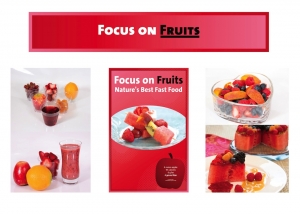
Fruit Bulletin Board Kit
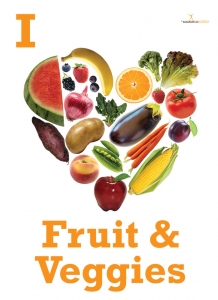
I Heart Fruit and Veggies Poster

Watermelon “Cake” Recipe Card



